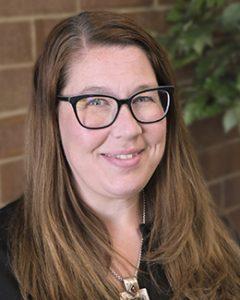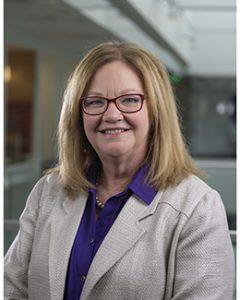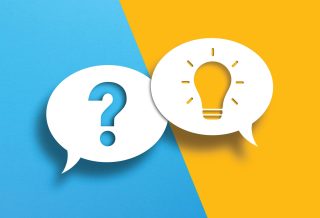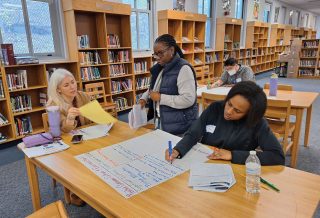FOCUS
A coaching endorsement program blossoms in Utah
By Katie Dewey Hill and Janice Bradley
Categories: Coaching, Learning communities, System leadershipDecember 2024
How do we develop the capacity for every instructional coach to provide job-embedded professional learning for every teacher and student? This was the question facing the Utah State Board of Education in 2020. To address this, the state board’s quality instruction team designed and built a statewide networked professional learning system that includes instructional coaches, local education agencies, administrators, state leaders, and university partners.
The quality instruction team had already developed a set of instructional coaching competencies, which defined the skills of an effective instructional coach. Educators could earn a new coaching endorsement, added to their educator license, based on demonstration of the competencies. But a key ingredient was missing: professional learning aligned to the competencies through which an educator could develop their skills and gain the endorsement.
Beginning in February 2020, our team began envisioning a systemic, scalable way for the quality instruction office to support such professional learning. We ultimately developed the USBE Instructional Coaching Endorsement, based on best practices in coaching (Aguilar, 2013; Killion et al., 2020; Knight, 2017) and the Standards for Professional Learning (Learning Forward, 2022). In designing the program, we paid particular attention to common implementation barriers and strategic ways to remove those barriers, such as using high-impact, low time commitment strategies for achievable and manageable implementation.
Stronger together ! Across Utah, partners built bridges and cultivated relationships to create coaching competencies across the state. 850+ educators have participated in the Instructional Coaching Endorsement series. Share on X
! Across Utah, partners built bridges and cultivated relationships to create coaching competencies across the state. 850+ educators have participated in the Instructional Coaching Endorsement series. Share on X
The central role of partnerships
To balance the need to create sustained professional learning with limited personnel from the state office, we needed to build bridges to all those with a stake in the effectiveness of instructional coaching and professional learning throughout Utah. From the outset, we knew partnerships were important for developing a shared understanding of coaching competencies across the state, in both urban and rural areas. We also wanted to communicate the value of the coach’s role to decision-makers who influence investments and funding allocations.
We drew on and further cultivated relationships with the state superintendent, local education agency leaders, instructional coaches, administrators, university instructors, regional service agencies, and local school board members. The table below outlines the critical roles they played in realizing the success of the statewide system.
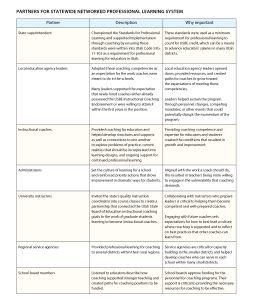
Regional service agencies play an important role, particularly in supporting rural and small local education agencies that have historically not had the same access to coaching support and alignment to the state board’s resources and initiatives. The result has been more investment in coaching and more access to knowledgeable coaches for more classroom teachers.
Instructional coaching capacity building model
At the heart of this initiative is the instructional coaching capacity building model (see table below), which has three components:
- Coursework, which builds instructional coaches’ professional expertise and competencies. Participants engage in three courses, one each in the fall, spring, and summer semesters: Foundations of Instructional Coaching, Adult Learning Theory, and Instructional Design and Assessment.
- Community of practice, which provides opportunities to develop a culture of collaborative inquiry among coaches across the state.
- Personalized support from expert coaches and field leaders to ensure access to timely and individualized assistance for each coach’s needs.
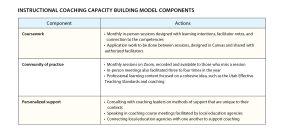
The model’s design recognizes that professional learning must be ongoing and sustained to impact practice and that professional development with a one-time single engagement session would not be enough to accomplish the goal of building capacity for coaching in all schools.
The model was also designed around the categories of the Standards for Professional Learning to ensure coaches engage in rigorous content, transformational processes, and conditions for success (Foster, 2022; Learning Forward, 2022). The Utah state board is committed to implementing the standards throughout the state to improve the professional learning experiences of Utah’s educators.
Attendance in monthly sessions includes 30 to 40 coaches and leaders joining the live session, with additional participants viewing the recording and contributing to the application discussion in the online course. More than 350 coaches and leaders subscribe to an email discussion group where we post coaching updates such as meetings and resources.
Through connection to the coaching group, quality instructional coordinators from the state board can visit coaches in local education agencies, attend and facilitate course meetings, and show support for their work. Statewide conferences, such as the Utah Coalition for Education Technology and Utah Rural Schools Association, have dedicated coaching strands in which coaches from across the state present and participate in sessions that extend impact to the wider community.
As coaches engage in the courses, community of practice, and personalized support, they deepen their knowledge of the standards. Then, guided by the standards, they can facilitate the same courses in their own context for existing and aspiring coaches. This improves the quality of coaching and makes best practices in professional learning a habit.
Through learning about what has worked well in the coaching program, team members at the state board also learned about the conditions needed for success, which includes who needs to be included in the process of developing the local programs, who needs to facilitate, and who needs to be invited to participate. Designing the courses with thorough facilitator notes, guides, and technology support helped remove the resource barriers that can derail the most well-intentioned programs.
The impact on educators
More than 850 educators have participated in the yearlong professional learning included in the Instructional Coaching Endorsement course series since 2020, and the learning continues today. Some districts now require completion of this endorsement for educators applying to instructional coach positions, which has resulted in a hiring pool with stronger understanding of the fundamentals of effective coaching and clarity about the role.
One large district leveraged this endorsement to create a shared understanding of the expectations for coaching roles in each content or specialty area. The district created a structure for diverse departments to collaborate, ensuring classroom teachers have aligned support from the various coaches and specialists as they work to build practice. Formerly, coaches and specialists sometimes competed for teachers’ or administrators’ attention. Now they can more readily collaborate with one another, ensuring students are the focus of the coaching work and teachers have the opportunity to maximize coaching.
We see results of the Instructional Coaching Endorsement program in diverse parts of the state. Coaching has seen a greater investment in rural communities, as education leaders recognize that an important component of teacher retention is support for practice. In more urban settings, coaching has historically been more prolific, but the challenges with coordinating multiple coaches have been difficult in some settings.
The endorsement has helped leaders in many of these districts have conversations that have led to improved coordination. This ensures that different departments have a shared vision for what coaching should accomplish and challenges coaches to work together to meet the needs of educators and their students.
Perhaps most importantly, the model is helping participants apply the coaching competencies in a meaningful way in the service of improved instructional practice. For example, in Utah we emphasize the importance of personalizing instruction for students according to the Universal Design for Learning model (Rose & Dolan, 2000; CAST, 2024).
Coaches report a greater understanding of how to personalize instruction for K-12 students, as well as personalizing professional learning for their teachers. This has brought more consideration for learning designs as they align with the Standards for Professional Learning, adult learning best practices, and how coaching can sustain the learning through application in practice. This has been evident in learning design proposals submitted to the state board having shown increased meaningful alignment to the standards.
Growing the partnership
A statewide coaching community of practice meets monthly to connect coaches who wouldn’t otherwise meet. They find value in seeing how others in their position have addressed the problems of practice that are relatable to their own situations. Coaching can be a unique and often lonely role. Meeting other coaches has helped participants be part of a network of others developing their craft in this specific context (Lave & Wenger, 1991; Lotter et al., 2014). This community of practice has also helped keep the decisions made at the state level connected to the realities encountered in Utah schools.
Coaching work is vital to sustaining professional learning and has driven the vision for systems of support to help define the role and the competencies necessary to coach effectively. The bridges built between the Utah State Board of Education and statewide partners have helped decision-makers across the system prioritize the important coaching position, communicate to stakeholders the importance of professional learning through coaching, and build capacity for greater growth for educators and students in every corner of the state.
References
Aguilar, E. (2013). The art of coaching: Effective strategies for school transformation. John Wiley & Sons.
CAST. (2024). Universal Design for Learning guidelines, version 3.0. udlguidelines.cast.org
Foster, E. (2022). Standards for Professional Learning: The research. Learning Forward.
Killion, J., Bryan, C., & Clifton, H. (2020). Coaching matters (2nd ed.). Learning Forward.
Knight, J. (2017). The impact cycle: What instructional coaches should do to foster powerful improvements in teaching. Corwin Press.
Lave, J. & Wenger, E. (1991). Learning in doing: Social, cognitive, and computational perspectives. Situated Learning: Legitimate Peripheral Participation, 10, 109-155.
Learning Forward. (2022). Standards for Professional Learning.
Lotter, C., Yow, J.A., & Peters, T.T. (2014). Building a community of practice around inquiry instruction through a professional development program. International Journal of Science and Mathematics Education, 12, 1-23.
Rose, D. & Dolan, B. (2000). Universal Design for Learning: Associate editor’s column. Journal of Special Education Technology, 15(4), 47-51.
Categories: Coaching, Learning communities, System leadership
Recent Issues
LEARNING DESIGNS
February 2025
How we learn influences what we learn. This issue shares essential...
BUILDING BRIDGES
December 2024
Students benefit when educators bridge the continuum of professional...
CURRICULUM-BASED PROFESSIONAL LEARNING
October 2024
High-quality curriculum requires skilled educators to put it into...
LEARNING TO PIVOT
August 2024
Sometimes new information and situations call for major change. This issue...



